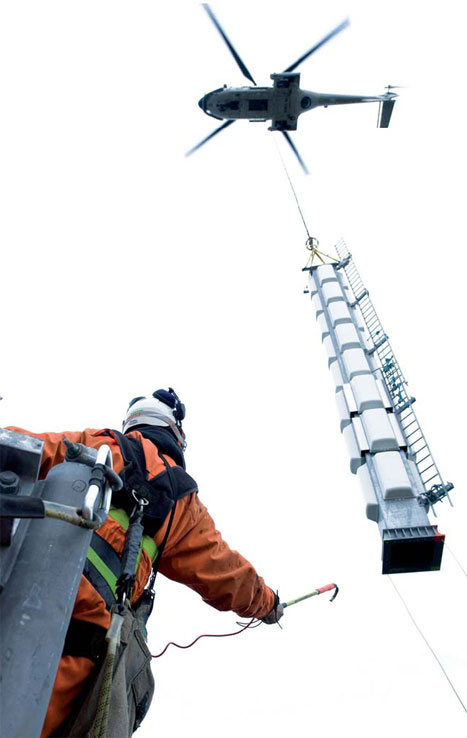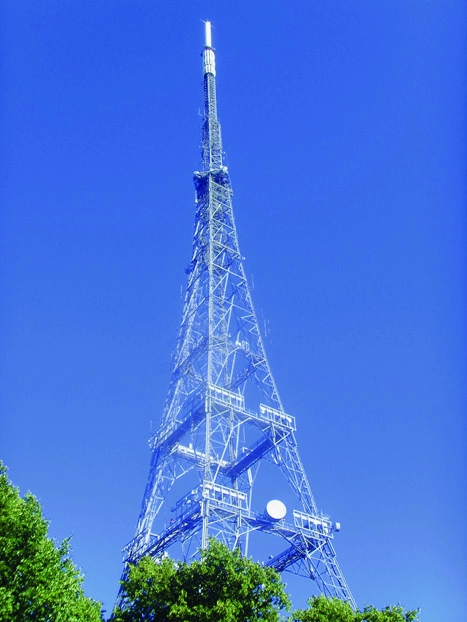The historic Crystal Palace transmission mast has been a landmark for lost travellers in the suburbs of southeast London for more than half a century. Towering over the boroughs of Croydon and Bromley, the huge 720ft lattice structure is considered by some to be one of Britain’s major engineering feats.
But while many people view the structure as an unchanging cultural icon, behind the scenes engineers are making significant modifications to the steel mast in preparation for the 2012 Digital Switch Over (DSO). The initiative is part of government plans to make Britain the world’s ’digital capital’ and will see transmission towers throughout the country overhauled in what is set to be the biggest and most complex re-engineering project in broadcast history.

Mike Hughes, broadcast director at Digital UK, believes the impact of the switchover will be far-reaching. ’Digital requires far less bandwidth, so more broadcast space can be opened up for things such as wireless broadband and high-definition television,’ he said. ’But the switchover isn’t going to be easy. Once you start talking about digital technology, people think about tiny chips in boxes. They don’t understand the size of the engineering involved.’
Arqiva, the company behind most of Britain’s existing broadcast infrastructure, has been tasked with upgrading around 1,150 TV transmitters throughout the UK. The total cost of doing this is estimated to be around £700m, and when complete will provide Digital Terrestrial Television (DTT) to more than 98.5 per cent of households in Britain.
Surprisingly, admits Hughes, Digital UK is currently on track to be £55m under its allocated £200m budget. But while money may not yet be a concern, one thing that Arqiva is running short of is time. The seven-year project is now halfway through and engineers are racing to finish the switchover for 10 of the 15 allocated TV regions. Crystal Palace is expected to be the sole transmitting hub for London and will be one of the last regions to switch over, along with Ulster, Tyne Tees and Meridian.
It’s the first time heavy-lift helicopters have been used for this application in the UK
Chris Turner, Babcock
’Crystal Palace is undoubtedly one of the biggest and most important upgrades of the project,’ said site manager David Houghton. ’Everything is here - high-power radio, both BBC and commercial radio and all sorts of other site-sharing services transmitting to a huge centre of the population. A lot has been learnt from some of the other projects and that has already helped with the upgrades.’
Work at the site to strengthen the main structure is already complete and preparations are underway to install two new antenna systems. But getting the fragile three-tonne sections into position at more than 700ft off the ground is no easy task. At Crystal Palace, the process is expected to take several weeks and will be carried out using a derrick that will hoist the massive antennas up on controlled lines from the ground.
In areas where time is running out, however, Arqiva has employed a more radical method of installing the new antennas. ’We’re using helicopters to work on the top of some of the structures,’ explained Chris Turner, chief executive for business and strategy at subcontractor Babcock. ’It’s the first time heavy-lift helicopters have been used for this application in the UK but it has proved to be extremely successful. We can now complete lifts in hours rather than weeks, and the cost is roughly the same.’
More than 20 helicopter lifts have been completed in the UK as part of the digital switchover programme. On most sites, an average of six lifts will be done in order to dismantle and install sections of antenna, taking around 10 minutes each to complete. Michael Newman, director of the helicopter operating company Helirig, believes that the dramatic lifts have caught the attention of both the public and industry and could be the future for heavy-lift engineering operations. But the process also comes with its own challenges.
On most sites, an average of six lifts will be done in order to dismantle and install sections of antenna
’One of the difficulties in the DSO projects has been an accurate determination of the weight that you are lifting off the mast,’ said Newman. ’The helicopter has a finite lifting capacity, which is around five tonnes, so you need to establish the weight of the existing steel that’s coming down - sometimes this can be very old steel for which the drawings might be unavailable or unclear. So we need to be diligent in measuring and calculating the weight of these elements to make sure it’s not going to be heavier than we can handle when dismantling.’
The work on the masts is weather-dependant and installation of the antennas must be done between April and September. This means that around 13 main transmitters and 288 relay transmitters have to be installed each year to complete the switchover programme. ’This year has been quite good so far, but the previous three summers were particularly bad,’ said Peter Heslop, Arqiva’s DSO programme director. ’I think we’ve officially had the three wettest summers in the last 100 years, which is why a lot of sites are now using helicopter lifts.’
Maintaining all the analogue TV services while the upgrades take place is another challenge. During switchover, most areas will experience a temporary shutdown or reduced operation in analogue television, radio, and mobile telephone signal. ’At Crystal Palace we have switched analogue services to the reserve antenna systems, which are a bit lower down on the tower,’ said Heslop. ’At the same time we are dismantling the old antenna systems on top of the tower and as soon as we’ve completed one of those, the analogue services can be transferred back, freeing up the reserve antenna for replacement and hopefully minimising disruption.’
In parallel with upgrades to the transmission systems on the towers, engineers are also working to make digital systems available on the ground. ’We’ve got to upgrade power systems and back-up power systems, build refurbishments - so completely stripping out and rewiring areas to receive the new transmitters,’ said Heslop. ’It’s a huge logistical challenge.’
When complete, the digital switchover programme will allow virtually anyone with an aerial in the UK to receive digital television. Hughes warned that a number of factors may lead to reception problems, including old installations that may not be directed at the right transmitter for the area and self-installed aerials, with the band pointing away from the transmitter. But once the initial hurdles have been overcome, breaking away from the restrictions of analogue could, according to the government, usher in a new era in digital television.

National Treasure
The Crystal Palace mast is one of Britain’s major engineering feats.
Nicknamed London’s Eiffel Tower, the Crystal Palace transmission mast sits towards the northeast corner of Crystal Palace Park. The structure was built in 1956 to succeed the transmitter at Alexandra Palace, where the world’s first scheduled television service was delivered in September 1936.
At the time of construction it was London’s tallest building, and remained so until 1 Canada Square (the Canary Wharf tower) was built in 1991. Initially it only transmitted the BBC on the old VHF 405-line systems, and a separate transmitter was built in Croydon to broadcast ITV. However, over the years the mast has become home to many more frequencies and gained a reputation as a cultural icon. The tower was recently voted in as one of 33 landmarks that will represent London in the run-up to the 2012 Olympic games.





Nanogenerator consumes CO2 to generate electricity
Whoopee, they've solved how to keep a light on but not a lot else.